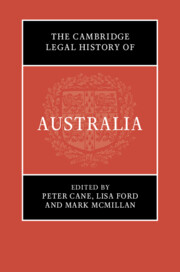Book contents
- The Cambridge Legal History of Australia
- The Cambridge Legal History of Australia
- Copyright page
- Contents
- Figures
- Maps
- Contributors
- Maps
- 1 Editors’ Introduction
- I Cultures of Law
- II Public Authority
- III Public Authorities in Encounter
- IV Land and Environment
- V Social Organisation
- 18 Colonial Law and its Control of Aboriginal and Torres Strait Islander Families
- 19 The Legal History of Non-Indigenous Marriage
- 20 Protection Regimes
- 21 Economic and Social Welfare
- 22 Civil Rights and Indigenous People
- 23 Rights
- 24 Citizenship and Immigration
- VI Social Ordering
- VII Reckonings
- Index
21 - Economic and Social Welfare
from V - Social Organisation
Published online by Cambridge University Press: 04 August 2022
- The Cambridge Legal History of Australia
- The Cambridge Legal History of Australia
- Copyright page
- Contents
- Figures
- Maps
- Contributors
- Maps
- 1 Editors’ Introduction
- I Cultures of Law
- II Public Authority
- III Public Authorities in Encounter
- IV Land and Environment
- V Social Organisation
- 18 Colonial Law and its Control of Aboriginal and Torres Strait Islander Families
- 19 The Legal History of Non-Indigenous Marriage
- 20 Protection Regimes
- 21 Economic and Social Welfare
- 22 Civil Rights and Indigenous People
- 23 Rights
- 24 Citizenship and Immigration
- VI Social Ordering
- VII Reckonings
- Index
Summary
The economic and social welfare of people living in Australia has been shaped by different sets of laws: Indigenous laws that meant individual welfare was ensured by family and kin, British laws that decreed welfare a distinct domain for managing the casualties of a hierarchical social order, and a settler colonial adaptation of the British system in which the colonial state provided the infrastructure for growth. This chapter argues that while state investment worked in positive ways for settler economies, it acted as the motor of Indigenous dispossession – though Indigenous communities maintained customary law and adapted settler welfare for their own well-being. White women were marginalised in settler economies but feminist agitation focussed on state welfare as the source of reform. The last 30 years have seen social investment in retreat, though it was revived during the Global Financial crisis and against Covid-19. The early 21st century has also witnessed the increasing dissemination of Indigenous ideas of well-being. The histories of these enduring strands provide some clarity on how we might approach what some have argued is impending automation and a ‘post-work future’.
- Type
- Chapter
- Information
- The Cambridge Legal History of Australia , pp. 502 - 522Publisher: Cambridge University PressPrint publication year: 2022



